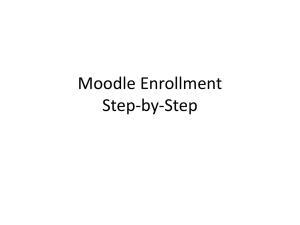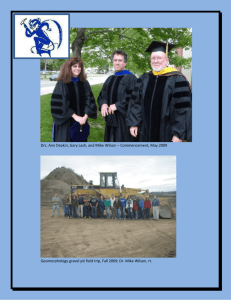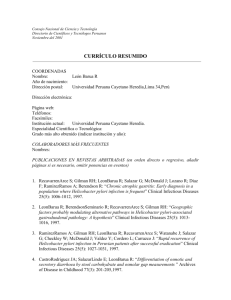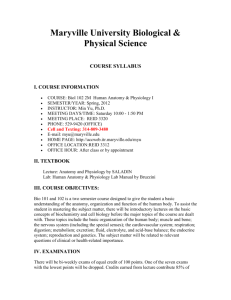Neuroscience & Behavior 260 - Home page for Harry Sinnamon
advertisement
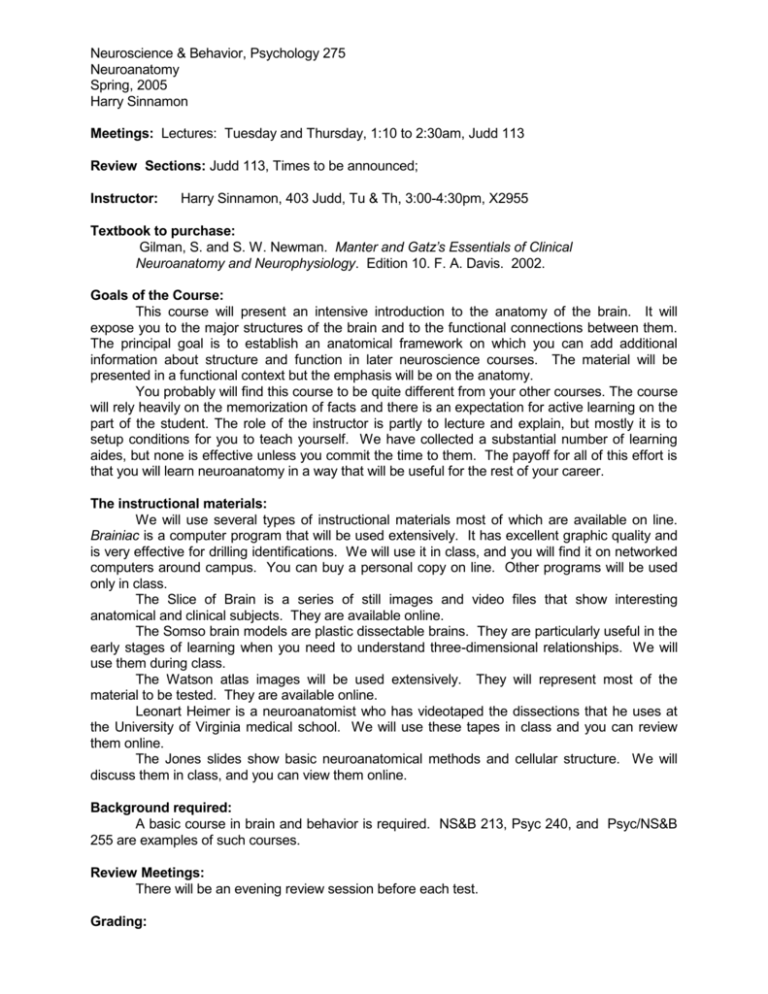
Neuroscience & Behavior, Psychology 275 Neuroanatomy Spring, 2005 Harry Sinnamon Meetings: Lectures: Tuesday and Thursday, 1:10 to 2:30am, Judd 113 Review Sections: Judd 113, Times to be announced; Instructor: Harry Sinnamon, 403 Judd, Tu & Th, 3:00-4:30pm, X2955 Textbook to purchase: Gilman, S. and S. W. Newman. Manter and Gatz’s Essentials of Clinical Neuroanatomy and Neurophysiology. Edition 10. F. A. Davis. 2002. Goals of the Course: This course will present an intensive introduction to the anatomy of the brain. It will expose you to the major structures of the brain and to the functional connections between them. The principal goal is to establish an anatomical framework on which you can add additional information about structure and function in later neuroscience courses. The material will be presented in a functional context but the emphasis will be on the anatomy. You probably will find this course to be quite different from your other courses. The course will rely heavily on the memorization of facts and there is an expectation for active learning on the part of the student. The role of the instructor is partly to lecture and explain, but mostly it is to setup conditions for you to teach yourself. We have collected a substantial number of learning aides, but none is effective unless you commit the time to them. The payoff for all of this effort is that you will learn neuroanatomy in a way that will be useful for the rest of your career. The instructional materials: We will use several types of instructional materials most of which are available on line. Brainiac is a computer program that will be used extensively. It has excellent graphic quality and is very effective for drilling identifications. We will use it in class, and you will find it on networked computers around campus. You can buy a personal copy on line. Other programs will be used only in class. The Slice of Brain is a series of still images and video files that show interesting anatomical and clinical subjects. They are available online. The Somso brain models are plastic dissectable brains. They are particularly useful in the early stages of learning when you need to understand three-dimensional relationships. We will use them during class. The Watson atlas images will be used extensively. They will represent most of the material to be tested. They are available online. Leonart Heimer is a neuroanatomist who has videotaped the dissections that he uses at the University of Virginia medical school. We will use these tapes in class and you can review them online. The Jones slides show basic neuroanatomical methods and cellular structure. We will discuss them in class, and you can view them online. Background required: A basic course in brain and behavior is required. NS&B 213, Psyc 240, and Psyc/NS&B 255 are examples of such courses. Review Meetings: There will be an evening review session before each test. Grading: Grading will be based on 3 in-class tests, one presentation/paper, and one final comprehensive examination. The weightings are: Test 1 (15%), Test 2 (10%), Test 3 (25%), Paper/Presentation (25%), and Final Test (25%). The tests will partly involve the presentation of slides to the class as a group. It is impossible to recreate the test conditions, so makeup tests present great difficulties. If you miss a test because of a medical problem, be prepared to provide documentation from your health care provider. If you miss a test because of a personal problem, have your Dean contact me. Do not miss the tests. The comprehensive final examination will be weighted at 25 % and will be given during examination week. The anatomy identifications on the final will be restricted to those covered in the in-class tests. You should keep your copies of the in-class test answer forms with the corrected answers as an aid for study in the final. There also will be questions based on the student presentations. Presentation/Paper: The last two weeks of class will be student presentations of neuroanatomical stories. The presentations will be 30 min expositions of a topic in functional anatomy. The goal will be to discuss primary literature (approximately 4 papers) showing a behavioral function that can be understood in terms of structure of the nervous system. A list of recommended topics is available online. Students will sign up on a first come, first served basis, so you may want to reserve your preferred time slot and topic early. A paper, approximately 5 pages in length, covering the same material will be due at the end of reading week. The oral and written presentations will combine equally for 25 % of the final grade. Neuroscience & Behavior 275 / Psychology 275 Neuroanatomy Spring, 2005 Harry Sinnamon Schedule of Class Meetings, Topics and Assignments Skim the assigned text material before the class. Study guides will be distributed in class. 1. 20 Jan Part 1: Basic & Gross Anatomy, Spinal Cord and Brainstem Introduction to the instructional materials Jones Slides: Neurons and Synapses 2. 25 Jan Gross and Cellular Anatomy Brain models Heimer tape 3 Gilman & Newman Chap 1 3. 27 Jan Gross and Cellular Anatomy Brain models Heimer tape 4 Gilman & Newman Chap 1 4. 01 Feb Gross anatomy and Peripheral nervous system Brain models Brainiac Gyri and Sulci Heimer tape 5,9 5. 03 Feb Spinal Cord Gilman & Newman Chap 3,4 Watson pp. 8-9, 13-15 Braniac, Pal-Weigert cord series 6. 08 Feb Spinal Tracts: Ascending Gilman & Newman Chap 6,7 Watson, 19-26 Braniac, Pal-Weigert cord series 7. 10 Feb Spinal Tracts: Descending Gilman & Newman Chap 8 Watson, pp. 44-46, 50-52 Braniac, Pal-Weigert cord series 8. 15 Feb TEST 1 (15 %) Test will cover Gross and the Spinal Cord 9. 17 feb Anatomy of Brainstem Medulla and Cranial nerves Brainiac, Pal-Weigert, brainstem series Gilman & Newman Chap 10, 11 10. 22 feb Pons, Midbrain and Cranial nerves Brainiac, brainstem series Gilman & Newman Chap 12, 14, 15 Watson, pp. 36-39 11. 24 feb Brainstem and Autonomic nervous system Brainiac, brainstem series Gilman & Newman Chap 5 12. 01 mar Watson, pp. 7-8, 46-49 Brainstem & Cranial nerves summary 13. 03 mar TEST 2 (10 %) Test will cover the Brainstem 14. 22 mar Part 2: Higher motor systems, Cortex & Limbic System Overview of Higher Motor Systems Heimer tape 11 Cerebellum Gilman & Newman Chap 16 Watson, pp. 52-62 15. 24 mar Basal ganglia Heimer tape 10 Brainiac, horizontal and frontal sections, Pal-Weigert Basal Ganglia Demo: Circuitry Gilman & Newman Chap 17 16. 29 mar Basal ganglia & Thalamus Brainiac, horizontal and frontal sections Gilman & Newman Chap 17 Basal Ganglia Circuitry 17. 31 mar Motor Disorders Basal Ganglia Demo: Pathology Parkinsonism Huntington's Disease Neurological assessment (Head to Toe, Pathological cases) 18. 05 apr Visual Pathways Gilman & Newman Chap 18, 19 Watson, 31-35 19. 07 apr Cortex: General Organization Brainiac Sulci & Gyri Gilman & Newman Chap 20 Eye Movement Watson, 41-44 20. 12 apr Hypothalamus and limbic system Gilman & Newman Chap 21, 22 Basal Ganglia and Limbic System Compared Chemical neuroanatomy Gilman & Newman, Chap 23 21. 14 apr review 22. 19 apr TEST 2 (25 %) 23. 21 apr 24. 26 apr Part 3. Neuroanatomical Stories, Student Presentations Student Presentations Test will cover Part 2 25. 28 apr Student Presentations 26. 03 may Student Presentations Final Examination (25 %) TBA Test will be comprehensive and include presentation material Presentation paper (1/2 of presentation grade) Due May 9, HMS mailbox, 5pm
